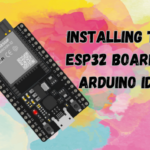Index
Introduction:
ESP32 can refer to either the bare ESP32 chip or ESP32 development boards. While using the bare chip is challenging for learning and prototyping, ESP32 development boards are practical. These boards include essential circuitry, power, programming capabilities, peripheral connections, LEDs, Wi-Fi antennas, and additional features like sensors, displays, or cameras for specific models like ESP32-CAM.
Selecting an ESP32 Development Board: What Factors to Consider?
When searching for ESP32 boards online, you’ll discover a variety of options. While they function similarly, certain boards may be better suited for specific projects.
- USB-to-UART Interface and Voltage Regulator:
- Essential features for connecting the ESP32 to your computer, uploading code, and providing power.
- BOOT and RESET/EN Buttons:
- Necessary for putting the board in flashing mode or resetting (restarting) it.
- Some boards automatically enter flashing mode without a dedicated BOOT button.
- Pin Configuration and Number of Pins:
- Access to the board’s pinout is crucial for proper ESP32 usage.
- Pinout provides a map of GPIO pins and their features.
- Antenna Connector:
- Most boards have an onboard Wi-Fi antenna.
- Some boards offer an external antenna connector, enhancing Wi-Fi range.
- Battery Connector:
- Certain development boards include connectors for LiPo batteries, useful for battery-powered setups.
- Regular ESP32 boards can also be powered by batteries through power pins.
- Extra Hardware Features:
- Some ESP32 boards come with additional hardware:
- Built-in OLED displays.
- LoRa modules.
- SIM800 modules for GSM and GPRS.
- Battery holders.
- Cameras, etc.
- Some ESP32 boards come with additional hardware:
Best ESP32 Development Board for Beginner
For those new to ESP32 development, we suggest opting for a board that offers ample GPIO options and lacks additional hardware features. Ensure it includes a voltage regulator and USB input for both power supply and code uploading.
We commonly utilize the ESP32 DEVKIT DOIT board in our projects, and this particular board, available in various pin configurations (30, 36, and 38), is our recommended choice for beginners due to its simplicity and consistent functionality across different versions.

GPIOs pin of ESP32
- The ESP32 chip features 48 pins with various functions, but not all are exposed on every development board, and some pins should be avoided.
- Power Pins:
- Commonly found on all boards: 3V3, GND, and VIN.
- Used for powering the board or other peripherals.
- General Purpose Input Output Pins (GPIOs):
- ESP32 GPIOs are identified by assigned numbers.
- The multiplexing feature allows customization of pins for UART, I2C, or SPI through code.
- Default pin configurations are set if not specified in the code.
- Specific GPIOs may have unique features suitable for specific projects.
- ESP32 DEVKIT V1 Pins Pinout:
- ESP32 DEVKIT V1 DOIT board typically provides 36 exposed GPIOs.
- GPIO placement may vary depending on the board model.
- Despite model variations, specific GPIOs function similarly across different boards, with exceptions.
- ESP32 GPIOs Detailed Guide:
- A comprehensive guide, the “ESP32 Pinout Reference Guide,” is recommended for in-depth understanding of ESP32 GPIOs.
- This guide details how to use ESP32 GPIOs and offers insights into selecting GPIOs based on project requirements.
- Consistent GPIO Functionality:
- While GPIO placement may differ based on the board model, individual GPIOs, such as GPIO5 for VSPI CS0 pin and GPIO 23 for VSPI MOSI in SPI communication, generally maintain consistent functionality regardless of the specific development board used.
How to Code for the ESP32?
Programming the ESP32 involves utilizing various firmware and programming languages. Options include:
- Arduino C/C++ with the Arduino core designed for ESP32.
- Espressif IDF (IoT Development Framework)
- Micropython
- JavaScript
Our recommended approach for ESP32 programming is through the C/C++ language within the Arduino framework. Although we also offer guides for MicroPython firmware, this guide specifically focuses on programming the ESP32 using the Arduino core. If MicroPython is your preference, please consult our guide: Getting Started with MicroPython on ESP32.


